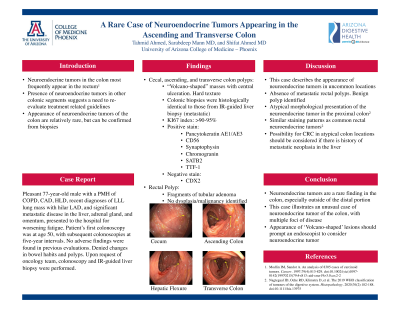Back


Poster Session D - Tuesday Morning
Category: Colon
D0156 - A Rare Case of Neuroendocrine Tumors Appearing in the Ascending and Transverse Colon
Tuesday, October 25, 2022
10:00 AM – 12:00 PM ET
Location: Crown Ballroom

Has Audio

Tahmid Ahmed
University of Arizona College of Medicine
Phoenix, AZ
Presenting Author(s)
Tahmid Ahmed, 1, Sarabdeep Mann, MD2, Shifat Ahmed, MD3
1University of Arizona College of Medicine, Phoenix, AZ; 2Arizona Digestive Health, Phoenix, AZ; 3Creighton University School of Medicine (Phoenix) Program/Saint Joseph's Hospital Medical Center, Phoenix, AZ
Introduction: Neuroendocrine tumors in the colon occur infrequently. When they do occur, they are most frequently found in the rectum. However, increasing incidence of neuroendocrine tumors in other portions of the colon suggests a need to re-evaluate current guideline related treatment.
Case Description/Methods: Pleasant 77-year-old male with a PMH of COPD, CAD, HLD, recent diagnoses of LLL lung mass with hilar LAD, and significant metastatic disease in the liver, adrenal gland, and omentum, presented to the hospital for worsening fatigue. Patient’s first colonoscopy was at age 50, with subsequent colonoscopies at five-year intervals. No adverse findings were found in previous evaluations. Denied changes in bowel habits and polyps.
Patient had undergone colonoscopy which had shown numerous ‘volcano-shaped’ masses with central ulceration. The lesions were found to be hard when biopsies were performed using cold forceps. The majority of these lesions were seen in the ascending and transverse colon. He had a single sessile polyp in the rectum, which appeared morphologically different than the proximal colon lesions. Per request of oncology team, a colonoscopy and IR-guided liver biopsy were performed.
Colonoscopy and liver mass biopsy demonstrate a high-grade neuroendocrine carcinoma with metastasis resulting in cecal, ascending colon, and transverse polyps. Rectal polyp was found to have fragments of tubular adenoma and did not have high-grade dysplasia. Fragments of colonic mucosa share foci that are morphologically identical to the mass in the liver biopsy. Immunohistochemical analysis on tissue from pertinent portions of colon identified cell populations positive for pancytokeratin AE1/AE3 (punctuate dot pattern), CD56, synaptophysin, chromogranin, SATB2 and TTF-1. CDX2 was found negative. Ki67 proliferative index for sample colon tissue was found to be greater than 90-95%.
Discussion: This case illustrates morphological appearances of neuroendocrine tumors of the colon. Interestingly, patient did not have a rectal neuroendocrine tumor, the most common location for neuroendocrine tumor within the colon. This case also characterizes both the endoscopic and histological appearance of neuroendocrine tumors. It is important for gastroenterologists to be aware of luminal neuroendocrine tumors given their increasing incidence.

Disclosures:
Tahmid Ahmed, 1, Sarabdeep Mann, MD2, Shifat Ahmed, MD3. D0156 - A Rare Case of Neuroendocrine Tumors Appearing in the Ascending and Transverse Colon, ACG 2022 Annual Scientific Meeting Abstracts. Charlotte, NC: American College of Gastroenterology.
1University of Arizona College of Medicine, Phoenix, AZ; 2Arizona Digestive Health, Phoenix, AZ; 3Creighton University School of Medicine (Phoenix) Program/Saint Joseph's Hospital Medical Center, Phoenix, AZ
Introduction: Neuroendocrine tumors in the colon occur infrequently. When they do occur, they are most frequently found in the rectum. However, increasing incidence of neuroendocrine tumors in other portions of the colon suggests a need to re-evaluate current guideline related treatment.
Case Description/Methods: Pleasant 77-year-old male with a PMH of COPD, CAD, HLD, recent diagnoses of LLL lung mass with hilar LAD, and significant metastatic disease in the liver, adrenal gland, and omentum, presented to the hospital for worsening fatigue. Patient’s first colonoscopy was at age 50, with subsequent colonoscopies at five-year intervals. No adverse findings were found in previous evaluations. Denied changes in bowel habits and polyps.
Patient had undergone colonoscopy which had shown numerous ‘volcano-shaped’ masses with central ulceration. The lesions were found to be hard when biopsies were performed using cold forceps. The majority of these lesions were seen in the ascending and transverse colon. He had a single sessile polyp in the rectum, which appeared morphologically different than the proximal colon lesions. Per request of oncology team, a colonoscopy and IR-guided liver biopsy were performed.
Colonoscopy and liver mass biopsy demonstrate a high-grade neuroendocrine carcinoma with metastasis resulting in cecal, ascending colon, and transverse polyps. Rectal polyp was found to have fragments of tubular adenoma and did not have high-grade dysplasia. Fragments of colonic mucosa share foci that are morphologically identical to the mass in the liver biopsy. Immunohistochemical analysis on tissue from pertinent portions of colon identified cell populations positive for pancytokeratin AE1/AE3 (punctuate dot pattern), CD56, synaptophysin, chromogranin, SATB2 and TTF-1. CDX2 was found negative. Ki67 proliferative index for sample colon tissue was found to be greater than 90-95%.
Discussion: This case illustrates morphological appearances of neuroendocrine tumors of the colon. Interestingly, patient did not have a rectal neuroendocrine tumor, the most common location for neuroendocrine tumor within the colon. This case also characterizes both the endoscopic and histological appearance of neuroendocrine tumors. It is important for gastroenterologists to be aware of luminal neuroendocrine tumors given their increasing incidence.

Figure: Image 1a: Transverse Colon
Image 1b: Hepatic Flexure
Image 1c: Cecum
Image 1d: Ascending Colon
Image 1b: Hepatic Flexure
Image 1c: Cecum
Image 1d: Ascending Colon
Disclosures:
Tahmid Ahmed indicated no relevant financial relationships.
Sarabdeep Mann indicated no relevant financial relationships.
Shifat Ahmed indicated no relevant financial relationships.
Tahmid Ahmed, 1, Sarabdeep Mann, MD2, Shifat Ahmed, MD3. D0156 - A Rare Case of Neuroendocrine Tumors Appearing in the Ascending and Transverse Colon, ACG 2022 Annual Scientific Meeting Abstracts. Charlotte, NC: American College of Gastroenterology.
